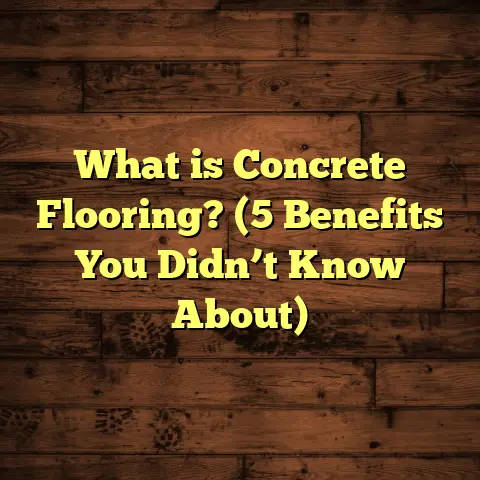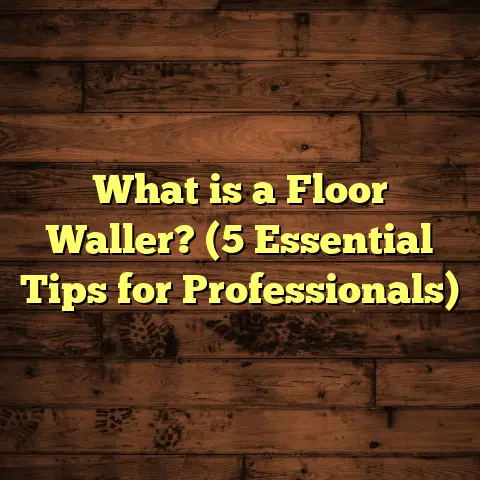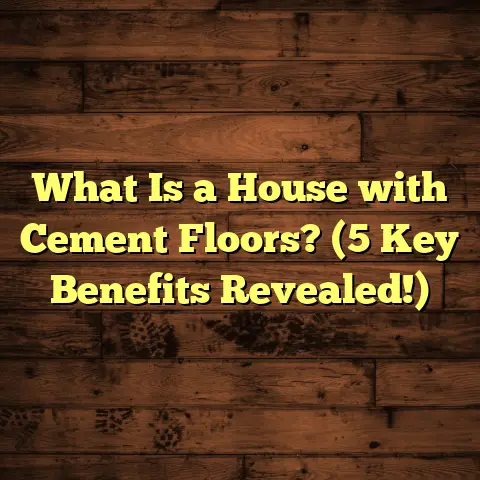What is the Best Flooring Option? (5 Factors to Decide Today)
I remember when I first needed to pick flooring for my home—it was a real headache.
I stood in a showroom, surrounded by endless samples and options.
Each type promised something different: durability, style, ease of cleaning, or affordability.
But none of it seemed straightforward. I felt stuck.
Have you ever been there? Wondering if the floor you choose today will still look good and hold up in five or ten years?
Or maybe you’re worried about spills, scratches, or that annoying creak underfoot?
That’s exactly where I was.
Over years of installing floors and helping friends and clients decide, I’ve learned one big truth:
There’s no single “best” flooring for everyone.
Instead, the best flooring for you depends on some key factors unique to your space and lifestyle.
I want to share what I’ve learned about those factors, and how they can guide you to the right choice.
If you stick with me, I’ll share stories from my work, data-backed insights, and even tools I use to make decisions easier.
Let’s start by answering a simple question that can clarify everything.
What Is the Best Flooring Option?
What do people mean when they ask about the “best flooring option”?
I like to think of it as the flooring material that fits your needs most closely—not just in looks but in function, feel, cost, and upkeep.
For a young family with kids and pets, “best” might mean something ultra-durable and easy to clean.
For someone living alone who loves hosting dinner parties, it might be about style and elegance paired with moderate maintenance.
For a retiree focused on comfort and low effort upkeep, softness and warmth could be priorities.
The “best” floor is really a balance of several things:
- How long it lasts (durability)
- How it looks and complements your style (aesthetic)
- How comfortable it feels walking or standing on it (comfort)
- How much work it takes to keep it looking good (maintenance)
- What it costs upfront and over time (budget)
You might already have an idea which of these matter most to you. If not, that’s okay—I’ll walk through each one in detail.
When I first started working in this field years ago, I learned early that rushing into a decision without weighing these factors almost always leads to regret.
Some clients wanted the “best” hardwood floor but ended up frustrated by scratches from pets or water damage from kids’ spills.
Others chose carpet for softness but found it stained too easily or trapped allergens.
Over time I refined my approach: I ask questions first about lifestyle and preferences before suggesting materials.
Now I want to share those insights with you.
1. Durability: How Long Will It Last?
Durability is usually the factor that hits me hardest when choosing flooring.
I want floors that stand up to wear and tear without losing their charm.
What Does Durability Mean?
It means resistance to scratches, dents, moisture damage, stains, fading from sunlight, and general aging.
If you have kids or pets who run around a lot—or if the floor gets heavy daily foot traffic—you definitely want durable flooring.
Here’s a closer look at common flooring types ranked roughly by durability:
| Flooring Type | Durability Level | Details |
|---|---|---|
| Porcelain/Ceramic Tile | Very High | Resistant to scratches, water, stains; very long-lasting |
| Luxury Vinyl Plank (LVP) | High | Scratch and water resistant; flexible and tough |
| Laminate | Medium to High | Scratch resistant but vulnerable to standing water |
| Hardwood | Medium | Can scratch/dent but refinishes well over time |
| Engineered Hardwood | Medium | More stable than solid wood; similar wear patterns |
| Carpet | Low to Medium | Wears quickly in high traffic; stains easily |
| Bamboo | Medium | Hard but can scratch; moisture sensitive |
My Experience With Durability
One project that stands out was a family home with two energetic dogs and three kids under 10. The owners wanted hardwood for its look but worried about scratches and spills.
I recommended a high-grade vinyl plank floor instead. It mimicked wood beautifully but was waterproof and highly scratch-resistant. After a year, they were thrilled—no visible damage despite all the chaos.
In contrast, I’ve seen hardwood floors in similar homes needing refinishing every 3-5 years due to wear from pets’ nails and spilled drinks.
Data That Helps
According to the 2024 Flooring Durability Report by HomeAdvisor:
- Vinyl plank floors last 15-20 years on average with proper care.
- Hardwood floors can last 25-30+ years if maintained well but may need refinishing.
- Carpet typically lasts 5-10 years before showing significant wear.
- Tile floors can last 50+ years but grout needs care.
So if you want longevity with low hassle, tile or vinyl are solid bets. But if you love hardwood’s character and don’t mind refinishing every decade or so, it can be worth it.
What About Moisture?
This is a big durability issue many overlook until problems arise.
Basements, kitchens, bathrooms—these areas see water more often.
Vinyl and tile are excellent in wet areas; hardwood often warps unless very well sealed.
I once helped a client who installed hardwood in their bathroom—within months the floor cupped badly due to moisture.
2. Style and Aesthetic: What Look Fits You?
Flooring sets the mood for your whole house—or even just a room.
It’s the foundation of your interior design.
Matching Floors to Style
Are you drawn to rustic farmhouse charm? Cozy cabins? Sleek modern minimalism? Classic elegance?
Each flooring type lends itself better to certain looks.
Hardwood is the go-to for classic warmth and elegance.
Its natural grain patterns add character that few materials can match. The color options—from blond maple to rich walnut—are versatile.
Laminate flooring has improved tremendously in appearance over the last decade. The best types now closely mimic wood grains or stone textures at lower costs.
Vinyl plank flooring offers incredible variety—from wood looks to bold geometric patterns—and is often used in casual or contemporary spaces.
Tile brings clean lines and can be artistic—think Mediterranean patterns or large-format porcelain slabs.
Carpet brings softness and color depth but isn’t typically the centerpiece of style unless patterned boldly.
My Favorite Styles
A project I’ll never forget was installing hand-scraped hickory hardwood in an old Victorian home—
it brought out the warm tones in the architecture beautifully. The homeowners said it felt like stepping back in time but with modern comfort.
On another job for a trendy coffee shop, we chose concrete-look porcelain tile—clean, modern, durable—and customers loved the industrial vibe.
Style Trends & Data
According to Houzz’s 2024 Flooring Trends Survey:
- Natural wood tones remain top-rated for resale appeal.
- Vinyl plank sales increased by 35% year-over-year due to design variety.
- Patterned tile usage rose 20%, especially in kitchens and bathrooms.
- Sustainable materials like bamboo are gaining popularity among eco-conscious buyers.
So style preferences are evolving—and you can find materials that fit both timeless looks and current trends.
Longevity of Style
One tip I always share: avoid overly trendy styles unless you’re ready to change floors often.
Classic wood tones or neutral tiles tend to age gracefully. Bold colors or patterns may feel dated after a few years.
3. Comfort Underfoot: How Will It Feel Every Day?
You might not realize how much flooring affects daily comfort until you walk barefoot on different surfaces.
Hard vs Soft Flooring
Hard surfaces like tile and hardwood feel cool and firm underfoot—great for warmer climates or if you want an elegant look—but they can be tough on joints if you stand long periods.
Carpet offers softness and warmth—ideal for bedrooms or playrooms where you want cushioning.
Vinyl has advanced cushioning layers now that offer some softness yet retain durability.
Cork flooring is another interesting option—soft, warm, eco-friendly—with natural shock absorption properties.
My Comfort Considerations
When I installed flooring for my elderly parents’ home, comfort was at the forefront.
We chose cork floors in living areas because they reduce impact stress on knees and ankles while providing a warm surface year-round.
At my own house, I use area rugs over hardwood floors in spots where I stand often like the kitchen sink area—for added cushioning.
Science Behind Comfort
Research published by the American Podiatric Medical Association (2023) shows:
- Softer flooring reduces joint pressure by up to 30%.
- Standing long hours on hard floors can cause fatigue and discomfort.
- Carpet reduces sound transmission by up to 60%, making rooms quieter.
- Cork provides natural insulation against temperature extremes.
If comfort matters to you—especially if you have joint issues or spend lots of time standing—factor that into your choice.
4. Maintenance: How Much Time Will You Spend Upkeep?
This one often surprises people when they learn how differently floors behave day-to-day.
Easy vs High Maintenance
Hardwood is beautiful but needs regular sweeping to avoid dirt scratching the surface—and occasional refinishing every 7-10 years depending on wear.
Laminate is simpler: just sweep and mop lightly but avoid standing water which can warp planks.
Vinyl is probably the easiest: spills wipe away quickly without staining or warping.
Tile is also low maintenance but grout lines require periodic scrubbing or sealing or they look dingy quickly.
Carpet needs frequent vacuuming and professional cleaning every year or two—and stains can be tough if untreated fast enough.
My Maintenance Stories
I once installed hardwood floors for a client who loved their look but hated upkeep—they found sweeping daily tedious.
We later retrofitted with area rugs in high traffic areas which helped tremendously.
For a rental property I manage, vinyl plank flooring has been a lifesaver—minimal cleaning needed between tenants reduces turnover time drastically.
Data Point on Maintenance Preferences
Home Improvement Research Institute (2023) reports:
- 65% of homeowners prefer flooring requiring less than 30 minutes per week on upkeep.
- Vinyl and laminate are rated highest for ease of maintenance.
- Hardwood owners spend nearly double the weekly time caring for floors compared to vinyl owners.
- Carpet owners vacuum about twice as often as hardwood owners sweep/mop.
If your schedule is tight or cleaning isn’t your thing, vinyl or laminate could be better fits than hardwood or carpet.
5. Budget: What Will It Really Cost?
Budget isn’t just about how much you pay upfront—it’s total cost over time including installation, maintenance, repairs, and replacement.
Typical Price Ranges (Installed)
| Flooring Type | Approximate Cost per Sq Ft Installed |
|---|---|
| Hardwood | $8 – $15 |
| Engineered Hardwood | $6 – $12 |
| Laminate | $3 – $7 |
| Luxury Vinyl Plank | $2 – $8 |
| Ceramic/Porcelain Tile | $7 – $20 |
| Carpet | $2 – $5 |
| Cork | $5 – $10 |
Prices vary based on quality, region, labor costs, subfloor prep needs, and more.
How I Use FloorTally For Budgeting
When I plan flooring projects now, I rely heavily on FloorTally—a tool that helps me calculate total costs quickly based on local labor rates and material prices.
It lets me experiment with different materials side-by-side with accurate waste percentage built-in—so no surprise expenses pop up halfway through installation.
Using FloorTally saved me loads of time getting quotes from multiple suppliers and contractors separately—it consolidates everything so I see total project cost clearly upfront.
If budgeting causes headaches like it did for me early on, having this kind of clarity makes decision-making easier—and avoids nasty surprises later!
Long-Term Cost Considerations
Remember maintenance costs: hardwood refinishing can run $3-$5 per sq ft every decade; carpet cleaning might cost hundreds annually; tile grout sealing adds recurring cost too.
Durable floors like vinyl or tile might cost more upfront than carpet but save money over time by lasting longer with less care needed.
Bonus Factor: Environmental Impact
For some people—including me—how eco-friendly a material is matters too.
Sustainable options include bamboo (which grows fast), cork (harvested without killing trees), reclaimed wood (reused material), and some recycled-content vinyl products.
Avoiding toxic finishes or adhesives is another consideration for indoor air quality.
If this matters to you, check product certifications like FloorScore or GREENGUARD that verify low emissions.
Real-Life Case Studies From My Work
To make all this less abstract, here are some real examples from my projects:
Case Study #1: Family with Young Kids & Pets
They wanted durable yet warm floors for their open-plan living/kitchen area. We chose luxury vinyl plank with wood-look finish. It handled spilled juice and muddy paws without damage after two years—and cost less than hardwood would have installed fully ($7/sq ft vs $12/sq ft). They’re happy with easy upkeep too.
Case Study #2: Retiree Looking for Comfort
My client wanted soft floors that eased joint pain yet looked nice enough for guests. We installed cork flooring throughout living spaces plus area rugs in bedrooms. The client reported less foot fatigue after months of use—and the natural warmth made winters cozy without extra heating bills.
Case Study #3: Historic Home Renovation
For a Victorian-era home restoration project, hardwood was essential for authenticity. We installed reclaimed oak boards finished with natural oils instead of polyurethane for better breathability. The floor still looks fantastic after five years with only light maintenance needed annually. Cost was higher ($15/sq ft) but matched homeowner’s priorities perfectly.
How To Decide Your Best Flooring Option Today — Step by Step
Here’s a process I recommend based on my experience:
- List Your Priorities: Which matters most—durability? Style? Comfort? Maintenance ease? Budget? Environmental factors? Rank them.
- Assess Your Lifestyle: Kids? Pets? Entertaining? Climate? Daily routines?
- Research Materials: Look at pros/cons of hardwood, laminate, vinyl, tile, carpet based on your priorities.
- Request Samples: Feel textures underfoot; see colors in your home’s light.
- Use Tools To Budget: Enter dimensions/materials into FloorTally or similar apps for cost estimates including waste.
- Consult Professionals: Talk with installers or flooring experts who understand local conditions.
- Make Your Choice Confidently: With info in hand you’ll avoid common pitfalls—like choosing beautiful but fragile materials where durability matters most.
- Plan Installation Timing: Consider season/climate; humidity affects some materials during installation.
- Prepare For Maintenance: Buy recommended products and schedule regular care routines.
- Enjoy Your Floors!
Final Thoughts
Choosing the right floor isn’t easy—but it’s worth taking your time so you get something that fits your life well today—and stays great years down the road.
Here’s what I’d tell my friends:
- Think beyond just looks—focus on what really matters day-to-day.
- Don’t ignore maintenance time; it piles up.
- Budget realistically—including installation and upkeep.
- Use tools like FloorTally—they make cost comparisons clearer than spreadsheets or guessing.
- Ask yourself how long you want this floor to last—and what compromises you’re willing to make.
- Samples matter! Walk barefoot on them before deciding.
- Remember style trends change; classic choices age better.
- And finally: no floor is perfect—but there’s definitely one best suited for you right now.
If you want personalized advice based on your home specifics or have questions about particular materials or techniques—just ask me anytime!
I’ve spent years helping folks make these decisions easier—and I’m happy to share what works best so you don’t have to learn hard lessons the way I did early on.





